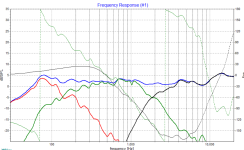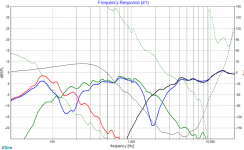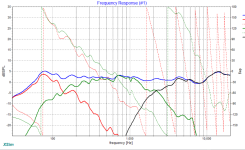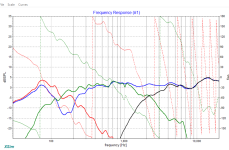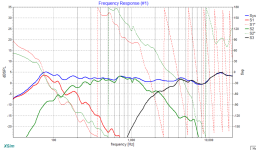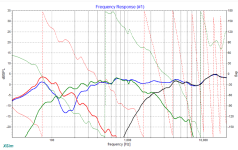Any issues with implementing the mid/tweet phase as shown?
Attachments
Last edited:
The phase behavior of the midrange puzzles me a bit. Otherwise: no, it seems fine to me.
Is that port on the bottom or a woofer in red?
If a woofer, make sure that woofer is normal polarity as shown on the left. If the woofer is flipped, then you need to flip all 3 drivers to get the positive bass motion as the positive pulse wave and the mid will be reversed.
Otherwise, it looks good to me too!
If a woofer, make sure that woofer is normal polarity as shown on the left. If the woofer is flipped, then you need to flip all 3 drivers to get the positive bass motion as the positive pulse wave and the mid will be reversed.
Otherwise, it looks good to me too!
@wolf_teeth - it is the woofer.
what I have is woofer flipped and mid and tweeter not flipped so woofer is neg polarity, mid and tweeter is pos polarity with sum and null shown by flipping woofer in att A and A1 with phase lines
I changed it to Woofer pos polarity and both mid and tweeter to neg polarity as shown in B and B1 - this is all 3 drivers flipped.
I might be missing something relating to "positive pulse wave"
to note: 1)The raw measurements are outdoor. The measurements match xover sims - got to love interferometry and XSim
2) I'm running the crossover in room and all checks out with sims..
what I have is woofer flipped and mid and tweeter not flipped so woofer is neg polarity, mid and tweeter is pos polarity with sum and null shown by flipping woofer in att A and A1 with phase lines
I changed it to Woofer pos polarity and both mid and tweeter to neg polarity as shown in B and B1 - this is all 3 drivers flipped.
I might be missing something relating to "positive pulse wave"
to note: 1)The raw measurements are outdoor. The measurements match xover sims - got to love interferometry and XSim
2) I'm running the crossover in room and all checks out with sims..
Attachments
Woofer needs to be normal polarity regardless. If the M and T were normal when woofer was flipped to get a flat summation, then both M and T should be reversed and the woofer normal for best results. This is perfectly fine even though it sounds funny.
It has to do with the pressure wave and how impact excites the room from the recording. Most of impact is the positive motion of the woofer cone.
For another illustration, measure the impulse of the woofer. The impact resides in the first rise of the cone motion, and is indicated by a peak in the impulse. The tactile feel will be subdued if the motion is inward to the cabinet as no pressure hits with the initial rise time. This is a difference in absolute phase.
If you have them constructed already with xover in place and wired with woofer reversed and M and T normal, just flip the polarity at the input terminals to the speaker, and this will remedy the issue. Listen both ways, and you should hear decay differences that help this make sense.
It has to do with the pressure wave and how impact excites the room from the recording. Most of impact is the positive motion of the woofer cone.
For another illustration, measure the impulse of the woofer. The impact resides in the first rise of the cone motion, and is indicated by a peak in the impulse. The tactile feel will be subdued if the motion is inward to the cabinet as no pressure hits with the initial rise time. This is a difference in absolute phase.
If you have them constructed already with xover in place and wired with woofer reversed and M and T normal, just flip the polarity at the input terminals to the speaker, and this will remedy the issue. Listen both ways, and you should hear decay differences that help this make sense.
This happens a lot in designs where the tweeter and mid or woofer diverge less than a octave above the xover point. This is mainly due to them being different drivers and not coincident.
The chances of any portion of a recording's absolute polarity (phase is a relative term) being that of the source recorded is at best around 50%.It has to do with the pressure wave and how impact excites the room from the recording. Most of impact is the positive motion of the woofer cone.
For another illustration, measure the impulse of the woofer. The impact resides in the first rise of the cone motion, and is indicated by a peak in the impulse. The tactile feel will be subdued if the motion is inward to the cabinet as no pressure hits with the initial rise time. This is a difference in absolute phase.
Wired according to the Pin 2 positive standard, a condenser (capacitor) microphone's output electrical polarity and phase response is the same as the acoustical waveform, while a moving-coil (dynamic) microphone's electrical waveform lags by 90 degrees.
Many devices in the recording path may invert polarity from input to output, and even after the adoption of the Pin 2 positive standard, there are many legacy products and some current ones wired as Pin 3 positive.
Many recording mixing consoles have polarity switches on each input, engineers decide which may sound "better" when combined.
Now that most mixing is done digitally, sources relative time can be altered, an infinite variation in phase.
JBL still makes woofers wired with opposite polarity to convention, positive voltage to the red terminal making the cone move toward the magnet structure.
Fortunately, the absolute polarity of the recorded event has no effect on our perception of it when played back over a loudspeaker, as can be confirmed by simply switching it’s polarity.
That said, current convention in speaker wiring generally is positive voltage to the woofer creates an outward cone movement, and the rest of the drivers are wired with the polarity that provides the closest phase alignment to the lower driver, dependent on the acoustical crossover order and driver relative position.
ctrlx, is there a reason it has to?
yeah, and you know what they are.
there are several threads with "phase tracking" in the title, such as The importance of phase tracking
then its up to the OP
I don’t have phase tracking above 3k per se, but I must have phase combining otherwise I wouldn’t have a “proper” notch with one driver flipped. Summed flat without this would produce bumps, dips and even flat through crossover region with one driver flipped.
sound is coherent with recorded detail exposed - but haven’t compared to other phase tracked speakers that I did as they are not home right now.
edit. I have Proac 1sc and LS3/5a - can play around with those..
sound is coherent with recorded detail exposed - but haven’t compared to other phase tracked speakers that I did as they are not home right now.
edit. I have Proac 1sc and LS3/5a - can play around with those..
Last edited:
ctrlx, the linked thread talks about how it's OK to have phase 90 degrees apart. Of course it should be done for the right reasons and third order Butterworth is a common example. This offers flat power and response whereas LR has a power dip and flat response.
- Home
- Loudspeakers
- Multi-Way
- Good reverse null with Midrange +180 deg and Tweeter -180 deg
